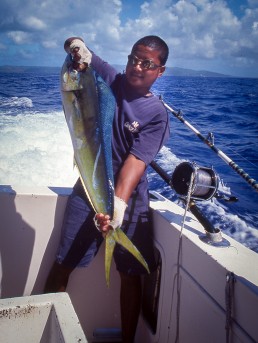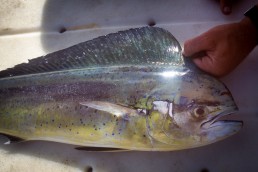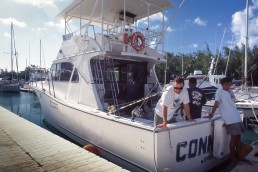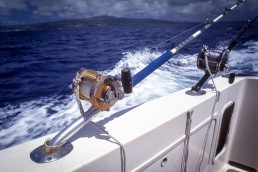On a day of sport fishing off the Micronesian island of Saipan, the seasickness is forgotten once the mahi-mahi start to bite. And all wraps up on a five-star gastronomic high.
“The dolphin was cold and a leprous grey-white now in the starlight and the old man skinned one side of him while he held his right foot on the fish’s head. Then he turned him over and skinned the other side and cut each side off from the head to the tail.”
TUCKED UP IN MY hotel bed, with a Pacific breeze wafting in to ripple the lace curtains, Hemingway’s passage in The Old Man and the Sea makes me squirm.
The writer’s grizzled Cuban fisherman, crouching in splintered skiff, digs a knife deep into Flipper’s flank. Flesh slides from the blade like shavings of a ripe mango, warm mammalian blood dripping down a brambly chin.
Twelve hours later, fishing off the Micronesian island of Saipan, our tattooed boat hand Stacey grabs the line with a leather-gloved hand and wrenches the day’s first hapless dolphin from the spray. Mechanical and detached behind wraparound Oakley shades, he plops it into the boat’s insulated catch box.
The dolphin flip-flops around for a minute or so like … well, like a fish out of water, before it gives up the fight and dies. Triumphant, we crack open more beers. Dinner is in the can.
Our first “dolphin” is not a real dolphin at all, of course, but a mere fish. Dolphin is the name used in the Caribbean for what the rest of the world calls a mahi-mahi, or sometimes a dorado. And if a fish is just a vegetable with gills, then a freshly line-hooked mahi-mahi is organically farmed Tuscan asparagus with a melted pecorino cheese and crispy herb dip.
And it tastes even better when you caught it yourself.
SAIPAN IS THE LARGEST of the Northern Mariana Islands, a United States commonwealth in the Western Pacific. Its palm-fringed beaches, affordable scuba-diving and water-sports, and year-round summer climes make it the go-to destination with young Japanese, who view sunny Saipan as akin to Hawaii, but less than half the distance from Tokyo, and so cheaper. South Koreans are also catching on to the island.
Fishing is another draw, with the potential for torpedo-like barracuda and tuna, even massive marlin and swordfish, and we had set out from the island’s Smiling Cove Marina that morning skittish with anticipation. The wind was up and cuddly clouds raced across a cerulean sky, the ocean as transparent as a drunk’s excuse.
As Connie II edged into the open sea, romantic tales of big men made small by the power of the sea crashed through our brains like tsunamis. We daydreamed of going mano a mano with creatures of the deep — of handsome, purple-hued marlin erupting from the abyss, thrashing scythe-like tails and rapier bills in final, futile acts of defiance. Just like in the glossy brochures, just like in a Hemingway yarn.
But the truth soon dawned on us puffy land-lubbers — unless you catch something massive on the double, deep-sea fishing just makes you sunburnt, drunk and wish you were someplace else. It also makes you throw up. Violently.
OUR BRIEF WAS to troll near the surface with plastic, squid-shaped lures attached to 500-pound breaking strength monofilament line. The lures seem to come in a rainbow of colours, including lavender, blue neon, fucsia and tequila sunrise.
As well as dandy squid, many pelagic denizens of the deep like to dine on flying fish, so we were on the lookout for those, along with bleached patches of loose sargasso weed and profiteering sea birds that swoop down on small fry terrified to the surface by the submarine equivalent of the school bully. The skipper studied a sonar rig in the hope of bouncing upon the odd leviathan truant.
My recently purchased book on fish, which I’d decided to rename The Combat Fisherman’s Big Fish-o-Pedia, was not much help. Its “where found” section only advising that marlin live “offshore”. But there was no time for swotting.
After just 20 minutes of cruising, we arrived at the fishing grounds, where we slowed to about five knots, which amplified the wave action and had us all shaking with nausea. Stacy had fixed up our gear en route and four fibre-glass poles flipped back from the perimeter rail, two of the taut lines held clear of our wake by creaking outriggers. Another brace of rods flanked the fighting chair, a wooden swivel-mounted affair bolted to the aft deck.
AND NOW, AFTER an hour of lolling around in circles, we are all decidedly green around the gills. Sloping off to try and throw up proves tricky with four bored people milling around a tub just 10 metres long, but I retire to the sardine-can head in as dignified a manner as possible.
A frantic thump, thump, thumping on the toilet door starts just as the second wave of convulsions is kicking in. By the time my puking has subsided, fellow fisherman Ivan has lost his breakfast over the side.
According to the skipper, a boatload of suffering Koreans can be a potent weapon in the deep-sea fisherman’s armoury, and he insists that a greasy slick of regurgitated kimchi can work the undersea kingdom into a let’s-storm-the-palace feeding frenzy.
Though Ivan is from Hong Kong, and he enjoyed an omelette as his morning meal, his titanic hurl into the Pacific seems to have worked a similar trick. From then on, the bites come thick and fast.
WHEN A MAHI-MAHI hits a colourful fake squid it hits it hard and at about 50 knots, and line fairly sizzles off the reel. Shouts go up, rookies panic and old hands sit back to enjoy the resulting chaos.
It is my turn so I stumble across the sun-bleached deck, feet apart and struggling to stay upright, and lunge for the hot seat. Stacy shoves the activated rod into the holding cup at my crotch and orders me to “pump, pump, pump”.
The 10-pounder at the end of the line stands little chance against such powerful tackle, but it’s important not to give the beast slack lest it throws the hook. So I pump and pump and pump and the battle is over in seconds.
The mahi-mahi is an ugly pug with a head shaped like an axe and a wide, Jagger-esque mouth packed with tiny razor blades
The Big Fish-o-Pedia says “the dolphin, family coryphaenidae, is a vivid blue-green in colour, fading to yellow on the sides. Its iridescent body may flash purple, chartreuse and other colours.”
In reality, the mahi-mahi is an ugly pug with a head shaped like an axe and a wide, Jagger-esque mouth packed with tiny razor blades, hence the need to get it boxed away and clear of fingers sharpish, lest a celebratory high five become a less than cheerful four or a miserable three.
Within two hours we have subdued eight of the critters, plus five small but perfectly bullet-shaped tuna. The day’s “big one” — a mahi-mahi that the skipper estimates at perhaps 30 pounds — proves to be, after a few minutes of spirited fight, the one that got away. Honest.
WITH CONNIE II SKIPPING back to the marina, I consider throwing the Big Fish-o-Pedia into her milky stern wave, but further reading and it feels fine to learn that we have avoided the ocean’s unattractive porgies, sheepsheads, weakfish, hagfish, grunts and snooks.
As is the way in Saipan’s fishing circle, we get to keep our two largest fish for the table. The remainder of our catch will be commandeered by the boat’s captain to be sold. Sport fishing is the preferred fish-harvesting method for the island’s hotels, so nothing goes to waste, though it does prove expensive for the amateur fisherman. At £300 for a three-hour trip — excluding beer — our catch cost us about £15 a pound, twice the price of fresh Scottish salmon steak in Sainsbury’s.
And once back on dry land, we photograph our catch before bagging up a brace of mahi-mahi and packing them in ice and off for Teppanyaki, Saipan’s best Japanese restaurant, at the sprawling, beachside Hyatt Regency.
Huddled around its open grill that evening, we sink cold Sapporo beers and Ivan enthrals anyone who’ll listen with his “20 minutes to eat breakfast, 20 seconds to lose breakfast” tale. The garrulous chef holds aloft the most impressive of our rainbow-hued mahi-mahi to whoops and cheers, before sending it back to the kitchen to be cleaned for the table. Enjoying the applause, he juggles eggs and catches them in his hat.
Though the aquatic treat we are about to eat may have chowed down on Ivan’s disgorged omelette, we are famished after the long day of fishing, drinking and puking, but gratefully not for long.
Mahi-mahi sashimi, mahi-mahi marinated in coconut milk and baked in a banana leaf, mahi-mahi fried rice … the fishy dishes kept coming until we start to feel unwell all over again. And we thank Neptune that the big one got away. ◉
This travel tale ran way back, in the 1990s — in one of the Australian men's mags, as I remember.
SHARE







